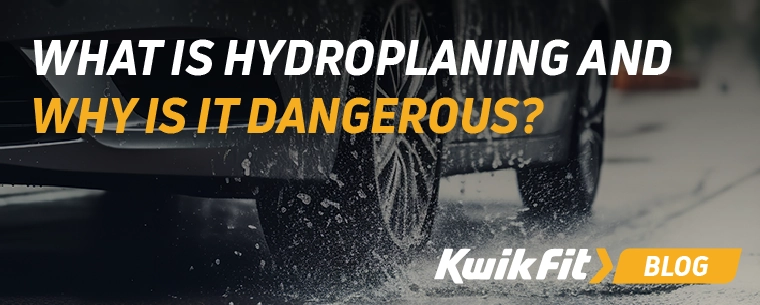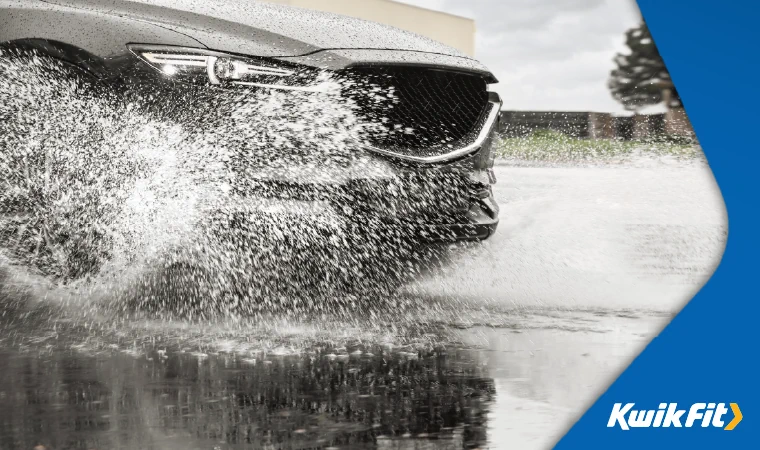What is Hydroplaning & Why is it Dangerous?
Jack Dreyer | Thursday 31st October 2024 12:30pm

Have you ever driven through standing water and felt your car start to drift away from you? Even though it may only last for a second or two, it can be a dangerous, not to mention stomach-churning, experience. With wet conditions and slippery roads causing an average of 4 deaths and serious injuries a day in the UK, hydroplaning is a major road safety issue.
Read on to learn how you can reduce the risk of hydroplaning, and also what to do should you find yourself losing control while driving through standing water.
What is hydroplaning?
When travelling on wet roads, tyres are designed to displace water. This helps them to maintain contact - or traction - with the road surface. Hydroplaning, or aquaplaning as it is also known, occurs when your vehicle loses contact with the road surface, usually while travelling over standing water. Along with road conditions, there are other factors that contribute towards hydroplaning, including your speed, your tyresí tread depth, and your vehicle weight.
Why is hydroplaning dangerous?
Hydroplaning can be a frightening experience for even the most seasoned of drivers, let alone a newly passed learner.
For those that haven't experienced hydroplaning before, the occurrence can be very dangerous because a driver can lose some or all control of the carís steering, braking, and acceleration. This can lead to skidding and the increased risk of a hazard or accident occurring.

When is hydroplaning most likely to happen?
As you may have guessed by now, hydroplaning is more likely to happen during or after heavy rainfall, where large amounts of water may have accumulated on roads. This is known as standing water - a body of water that doesnít move, for example puddles, drain water, and rainwater.
Take your foot off the gas, but avoid harsh braking
Sudden braking while hydroplaning could cause your car to spin out of control. But you do need to reduce your speed, so take your foot off the accelerator to slow your vehicle without using the brake pedal.
Gradually steer your car in the direction itís hydroplaning
This may feel like going against your instincts, but if your tyres donít match your direction of travel, itís going to be even harder to regain control once your car starts to find grip once more. Turn the steering wheel slowly to align your wheels with the direction of travel.
Wait until you regain control
As your vehicle starts to slow, itíll be easier to regain traction once youíve driven through the standing water back onto a dryer part of the road.
Check your tread depth regularly
Arguably, this is the most important one on the list. While the legal limit for the minimum tread depth is 1.6mm, it is not recommended to go below 3mm. Ideally, once you know or think your tread depth has reached 3mm, you should book in a tyre check with your local mechanic or professional.
There are several ways to tell whether your tread depth is too low and your tyres need replacing. This includes the 20p test - all you need to do is place a 20p coin into the grooves of your tyre and if the rim is hidden, the tyre is above the legal tread limit. Alternatively, the majority of tyres have tread wear indicators that you can check to determine the condition of your tyres.
Reduce your speed in wet conditions
Travelling at fast speeds in wet conditions or heavy rain doesnít give your vehicleís tyres enough time to remove water from between the treads, and this can increase the risk of hydroplaning. While vehicles can experience hydroplaning at any speed, the slower you travel over standing water and wet roads, the better chance you have of staying in control and reacting appropriately.
Avoid puddles and standing water
Finally, if possible, try to avoid travelling over puddles and standing water by steering around it, or at least away from the deepest part. If you know a particular area is prone to standing water, then changing your route to avoid it may be your best bet.
Book your next tyre check at Kwik Fit
If youíre worried about the condition of your tyres, Kwik Fit offers a no obligation free tyre check. Our expert technicians will be on hand to provide advice and recommendations for the best fit replacements, and with over 600 centres nationwide to choose from, thereíll be a Kwik Fit local to you. All helping you to stay safe behind the wheel.
For more tips about driving in hazardous conditions, including winter driving, check out the Kwik Fit blog.
Any facts, figures and prices shown in our blog articles are correct at time of publication.
Featured Articles
Is it Illegal to Drive With One Headlight?
Saturday 19th July 2025
Wondering if itís illegal to drive with one headlight? Learn about the safety risks and penalties of illegal blown bulbs and why you should fix them promptly.
Air Con in EVs & Hybrids: Experts Answer Your Questions
Monday 30th June 2025
Does air con drain EV batteries? Can you use the air con while charging an electric car? Find out the answers to these questions & more from Kwik Fitís experts.
Why Is Your Car Making a Noise? Fixes & Tips
Friday 13th June 2025
When your car starts making unexpected noises, it can certainly be quite disconcerting; it may be nothing to worry about, but hereís what you need to know.









